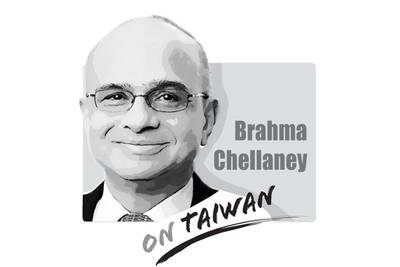There is an ongoing debate on whether Democratic Progressive Party (DPP) presidential candidate Frank Hsieh (
But a whole myth surrounds that debate.
The pan-blue camp is using this myth to attack the DPP government's "isolationist" policies in an attempt to push its consistent stance that Taiwan's future lies in China. In doing so, however, they disregard the fact that the capital invested in China accounts for more than 60 percent of Taiwan's total investment abroad.
Official statistics released by the government last year put the figure at 63.9 percent. In addition, Taiwan's exports to China made up 38.6 percent of the nation's exports last year. With such figures, how can there even be talk of isolationist policies? The pan-blue camp is simply using this issue to mobilize political support.
The pan-green camp has also taken advantage of this myth. If we look at the history of Taiwanese investment overseas, we are reminded that the government used to encourage companies and individuals to make indirect investments in China via a third country -- known as the "track two" option -- so that their investments would enjoy economic and trade protection enjoyed by other countries.
Today, although the government has begun, to a certain degree, to open the gates to direct investment in China -- the "track one" option -- many businesses still prefer "track two" because of its financial management and tax advantages. For companies with large projects requiring heavy investment or with a high profile, "track two" is not an option.
As a result, even though the pan-green camp keeps clinging to the "track one" option, domestic capital continues to flow to China via "track two" channels.
From a macroeconomic perspective, the fact that the "track one" option cannot prevent the outflow of capital indicates that the government's capital control capabilities have been eroded by the fast capital movements of globalization. From a public policy perspective, the government should examine the effectiveness of this policy tool.
In this light, Hsieh's proposal to adjust the "track one" mechanism has helped allay the pan-green camp's anxiety over capital outflows and resolve the "myth."
A closer look shows that its cleverness lies in the dynamic management of investment projects on a case-by-case basis, by which a committee or a small team will be formed to examine and decide on individual investment projects in China.
In other words, this mechanism would achieve both the goals of "active management" and "effective opening."
Still, some parts of Hsieh's proposal require clarifications.
How does his proposed committee, or small team, differ from the Ministry of Economic Affairs' Investment Commission and how should their functions be separated?
To deconstruct the legacy of authoritarian rule under the Chinese Nationalist Party (KMT), the DPP has followed up on the transition of political power by introducing elements of democratization outside the existing policy-making mechanism and established various commissions, such as the Environmental Protection Administration's environmental evaluation committee and other deliberative committees.
But these have resulted in violations of the democratic principle of balance between power and responsibility.
Lu Chun-wei is a doctoral student in the Department of Political Science at National Taiwan University.
Translated by Ted Yang

Donald Trump’s return to the White House has offered Taiwan a paradoxical mix of reassurance and risk. Trump’s visceral hostility toward China could reinforce deterrence in the Taiwan Strait. Yet his disdain for alliances and penchant for transactional bargaining threaten to erode what Taiwan needs most: a reliable US commitment. Taiwan’s security depends less on US power than on US reliability, but Trump is undermining the latter. Deterrence without credibility is a hollow shield. Trump’s China policy in his second term has oscillated wildly between confrontation and conciliation. One day, he threatens Beijing with “massive” tariffs and calls China America’s “greatest geopolitical
Ahead of US President Donald Trump and Chinese President Xi Jinping’s (習近平) meeting today on the sidelines of the APEC summit in South Korea, an op-ed published in Time magazine last week maliciously called President William Lai (賴清德) a “reckless leader,” stirring skepticism in Taiwan about the US and fueling unease over the Trump-Xi talks. In line with his frequent criticism of the democratically elected ruling Democratic Progressive Party — which has stood up to China’s hostile military maneuvers and rejected Beijing’s “one country, two systems” framework — Lyle Goldstein, Asia engagement director at the US think tank Defense Priorities, called
A large majority of Taiwanese favor strengthening national defense and oppose unification with China, according to the results of a survey by the Mainland Affairs Council (MAC). In the poll, 81.8 percent of respondents disagreed with Beijing’s claim that “there is only one China and Taiwan is part of China,” MAC Deputy Minister Liang Wen-chieh (梁文傑) told a news conference on Thursday last week, adding that about 75 percent supported the creation of a “T-Dome” air defense system. President William Lai (賴清德) referred to such a system in his Double Ten National Day address, saying it would integrate air defenses into a
The central bank has launched a redesign of the New Taiwan dollar banknotes, prompting questions from Chinese Nationalist Party (KMT) legislators — “Are we not promoting digital payments? Why spend NT$5 billion on a redesign?” Many assume that cash will disappear in the digital age, but they forget that it represents the ultimate trust in the system. Banknotes do not become obsolete, they do not crash, they cannot be frozen and they leave no record of transactions. They remain the cleanest means of exchange in a free society. In a fully digitized world, every purchase, donation and action leaves behind data.